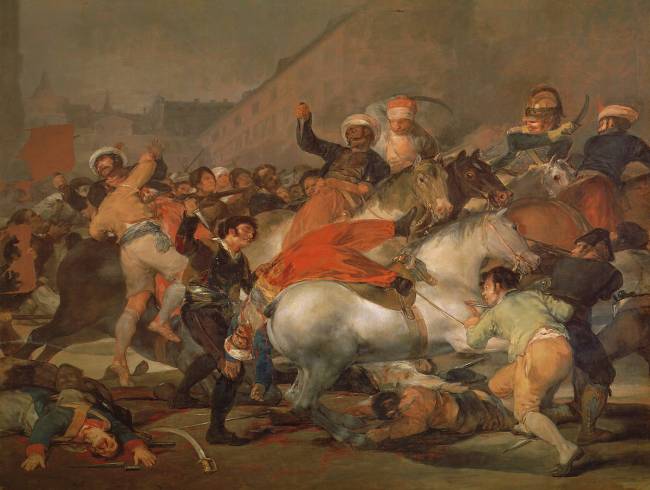Shop art print and framed art Dos de mayo by Francisco de Goya
Customise
Your art print
Dos de mayo OF Francisco de Goya

Dos de mayo
Historical background and origin of the painting Dos de mayo by Francisco Goya
In 1808, Spain was in the grip of an invasion by Napoleonic troops. On 2 May, in Madrid, a popular revolt broke out against the French occupiers. This day, known as the "Dos de Mayo", marks the beginning of the Spanish War of Independence.
A few years later, in 1814, the newly liberated Spanish government commissioned Francisco de Goya to paint two monumental canvases to commemorate this heroic episode. The Romantic-style oil on canvas Dos de Mayo, with its spectacular size of 268.5 cm high by 374.5 cm wide, and now in the Prado Museum in Madrid, is one of them, the other being Tres de Mayo, which depicts the bloody reprisals that followed the insurrection.
Visual description of Dos de mayo by Goya
The painting Dos de mayo depicts a chaotic scene in the streets of Madrid, where several groups of combatants are fiercely clashing. At the centre of the composition is a group of Mamelukes on horseback, Egyptian mercenaries in Napoleon's service, who violently charge the Madrilenians. The Madrilenians resist as best they can, using improvised weapons such as knives, sticks and rifles stolen from the French soldiers. The scene is chaotic and violent: bodies intermingle and weapons clash.
The artist was able to capture the intensity of the emotions and the brutality of the confrontations through a number of elements. The tumultuous movements of the figures, the dramatic colours used by Goya and the strong shadows accentuate this tragic atmosphere. The harsh, contrasting light highlights the expressions of terror, anger and despair on the faces of the combatants. The panicked looks and violent gestures of the combatants are reinforced by their close proximity, reflecting the surrounding chaos.
The composition, organised diagonally, creates an effect of movement and depth, reinforcing the dynamism of the scene. The characters are depicted realistically, without idealisation, emphasising the brutality of the struggle.
Symbolism and theme in the painting Dos de mayo by Francisco Goya
By exploring the details of this painting, we can discern several symbols and themes addressed by Goya. The artist has thus depicted Spanish patriotism and its struggle for freedom in the face of a foreign invader. The Madrilenians, although outnumbered and outgunned, show exemplary courage in the face of the French troops, depicted as violent and ruthless, underlining their status as enemies of the Spanish people, in order to defend their lands and their identity at all costs.
The role of Dos de mayo in Francisco de Goya's career
Dos de Mayo marks a turning point in Goya's career. Previously known for his portraits and genre scenes, here the artist embarks on a history painting charged with political meaning. He bears witness to the horrors of war and denounces blind violence.
This work prefigures the Disasters of War, a series of engravings produced a few years later, in which Goya depicts with uncompromising cruelty the atrocities committed during the conflict. Dos de Mayo is thus the starting point for a profound reflection on the human condition and the ravages of war, which would leave a lasting mark on the artist's work.
Beyond its importance in Goya's career, Dos de Mayo has also had a considerable impact on the history of art. With its dramatic intensity, realistic depiction of violence and denunciation of the atrocities committed during this historical episode, this powerful and engaging work has inspired many artists, from Manet to Picasso, and continues to challenge us today with its expressive power and universal message.
This artwork is a painting from the classical period. It belongs to the romanticism style.
« Dos de mayo » is kept at Prado, Madrid, Spain.
Find the full description of Dos de mayo by Francisco de Goya on Wikipedia.
You may also like
- 30% !
Make good deals by browsing our Reserve : editions of our catalog which await their purchaser at a low price.























